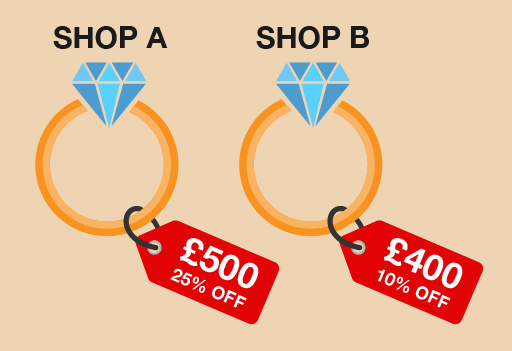5.1 Percentage increases and decreases
You’ll often see percentage increases and decreases in sales and pay rises.
Example: Anjali’s pay rise
Anjali earns £18 000 per year. She is given a 10% pay rise. How much does she now earn?
Method
In order to identify Anjali’s new salary, you need to find out what 10% () of £18 000 is. To do this, first you need to find out 1% () of £18 000:
18 000 ÷ 100 = 180
So 10% () of £18 000 is:
10 × 180 = 1 800
Alternatively, you could find 10% by dividing £18 000 by 10:
18 000 ÷ 10 = 1 800
Anjali’s pay rise is £1 800, so her new salary is:
£18 000 + £1 800 = £19 800
Example: A sale at the furniture shop
A furniture shop reduces all of its prices by 20%. How much does a £300 double bed cost in the sale?
Method
In order to identify the new price of the double bed, you need to find out what 20% () of £300 is. To do this, first you need to find out 1% () of £300:
300 ÷ 100 = 3
So 20% () of £300 is:
20 × 3 = 60
The discount is £60, so the sale price of the double bed is:
£300 – £60 = £240
Alternatively, you could find 20% of £300 by dividing by 10 (to find 10%) and then multiplying by 2:
300 ÷ 10 = 30
30 × 2 = 60
Use the examples above to help you with the following activity. Remember to check your answers once you have completed the questions.
Activity 35: Calculating percentage increases and decreases
- You buy a car for £9 000. Its value depreciates (decreases) by 25% annually. How much will the car be worth at the end of the first year?
- Since the start of the 21st century, the shares in the InstaBank have risen by 30%. If the price of one share was £10 in 2000, what is it worth now?
- The same diamond ring is being sold at different prices, and with different percentage discounts, in two different shops. Which shop offers the better deal?
Answer
- In order to identify how much the value of the car will decrease by, you need to find out what 25% () of £9 000 is. You can work this out in several different ways.
Find 1% () first:
- 9 000 ÷ 100 = 90
- 25 × 90 = 2 250
- 9 000 ÷ 4 = 2 250
- The car’s value depreciates by £2 250 in the first year, so the value of the car at the end of the first year will be:
- £9 000 – £2 250 = £6 750
- It might be easier in this example to convert £10 into pence (£10 = 1 000p). In order to identify the new value of the share, you need to find out what 30% () of 1 000p is. To do this, first you need to find out 1% () of 1 000p:
- 1 000 ÷ 100 = 10
- So 30% () of 1 000p is:
- 30 × 10 = 300
- £10 + £3 = £13
- 1 000 ÷ 10 = 100
- 3 × 100 = 300
-
In order to identify Shop A’s discount, you need to find out what 25% () of £500 is. To do this, first you need to find out 1% () of £500:
- 500 ÷ 100 = 5
- 5 × 25 = 125
- £500 – £125 = £375
- 500 ÷ 4 = 125
- 500 ÷ 2 = 250
- 250 ÷ 2 = 125
- 400 ÷ 100 = 4
- 4 × 10 = 40
- £400 – £40 = £360
- 400 ÷ 10 = 40
Summary
In this section you have learned how to calculate percentage increases and decreases. This will be useful when working out the value of a pay increase or how much an item will cost in a sale. You have also seen that there are different ways of working out percentages. You need to use the method that works for you.You may use different methods for working out different percentages.


